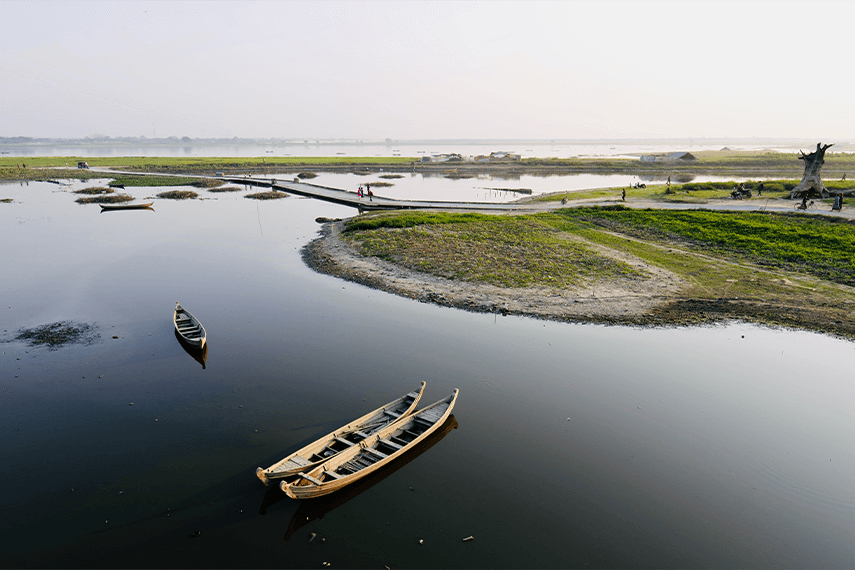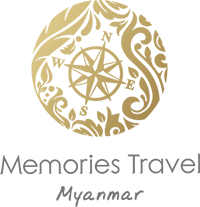Travel Information

Visiting Myanmar
Myanmar is fast becoming the next go-to destination in Southeast Asia. With an ever-growing list of tourist sights, including golden stupas, ancient ruins, pristine beach resorts and glittering cities, the country will leave you charmed, intrigued, and inspired to see more.
As a general rule, keep in mind that Myanmar remains steeped in tradition in many ways. It is recommended you adopt a respectful attitude towards traditions and the ancestral culture of this country.
Travel in Myanmar presents little risk, but it would be best to leave your valuables at home.
Myanmar is located on the Bengal Gulf, bordered by Thailand to the South-East, by Laos and China to the North-East and India and Bangladesh to the West.
The southern part of the country is flat, fed by many rivers; the largest one, the Irrawaddy, which rises in the foothills of the Himalayas, flows through spectacular gorges, tropical jungles and terraced paddy fields to the Bay of Bengal.
The Irrawaddy is the heartbeat of Myanmar and is the most viable means of access to many of the country’s attractions.
Myanmar has 70 million inhabitants with an average density of 73,9 inhabitants/km2. 68% of the population is Burmese, 9% Shan, 7% Karen, 4% Rakhine, 3% Chinese, 2% Mon and 2% Indian. Ethnic minorities make up the rest of the population of Myanmar.
The predominant religion is Theravada Buddhism (89%); however Christianity (4%), Islam (4%) and Hinduism (1%) are also present in the country. Similarly, like in other countries, try to avoid discussions on religion or keep them as discreet as possible, especially when you are in the presence of people speaking your language.
The country acquired independence from the United Kingdom in 1948. Nevertheless, from 1962 to 2011, the nation was under military control.
Myanmar is currently in democratic transition and is opening up progressively. As with religion, it is advisable to refrain from discussing politics except in very broad terms. People are increasingly open to discussion, although preferably in private. Foreign companies are combining efforts with the government and local businesses to develop the country in all domains.
There are more than 100 ethnic groups in Myanmar, all with their own language or dialect, tradition and culture. The majority of the population speaks Burmese, the official language. English is widely spoken.
However, communication and the understanding of local traditions can be a problem beyond the major cities. The presence of a guide able to speak several languages is highly recommended.
The official currency is the Kyat (MMK). Current notes are: ks 10,000, 5,000, 1,000, 500, 200, 100, and 50 bank notes.
At the time of writing the exchange rate is US$1 = 1,525 Kyat (2019) Please note that this can change significantly on a daily basis.
It is quite easy to find a money changer at the airport or in the city center. We recommend all tourists visiting Myanmar to bring cash in USD or Euros and exchange it into Kyats (Maximum: USD2,000).
ATMs are available mostly in Yangon. Payments by credit cards are now possible in most hotels, restaurants and select shops. Remember to inform your bank that you are travelling to Myanmar; otherwise the bank may block the card. Please be informed that all dollar bills must be in mint condition with no marks or folds. It is advisable to bring $100 bills as the exchange rate is higher.
The best time of year to visit Myanmar is from mid-October to the beginning of March. At this time, the climate is mild and dry. Temperatures can however be very low at high altitude and especially at night. This is the case for Inle Lake.
The hottest time of year is from March to mid-May and the rainy season lasts from mid-May to the beginning of October. The months of May and June are hot and humid. In July, August and September, the humidity is generally high in Yangon. It is less so in the northern regions (Bagan, Mandalay and Inle Lake). It’s an interesting period to visit the country as there are fewer tourists, the landscapes are greener and the prices are competitive.
In Myanmar the standard electrical current is 220V, but sockets are not always standard. It is highly recommended that you take an international adapter with you.
Due to its limited power supply, the country suffers from frequent power cuts and over voltage, but most hotels and restaurants in the major cities have their own generators.
As in many countries, it is not advisable to drink water from the tap. Please note that it is easy to purchase water bottles.
International phone call charges from Myanmar are very expensive (from 5 to 10 USD per minute for Europe). If you need to call from a hotel, it is advisable to check and have confirmed the price before making the call (“surprises” can be very costly!).
Mobile phone signal is very unstable in remote regions of Myanmar; however they can be used anywhere else in the country. Ooredoo, MPT and Telenor are currently developing and working on advanced telecommunication networks.
Wifi connections are more and more available, especially in the big cities (hotels, restaurants, cafes). Nonetheless, internet connection is still very limited (speed and capacity wise).
No vaccination is required; however visitors are recommended to be up to date with routine vaccinations (such as polio and diphtheria). Visitors are also advised to receive inoculations against hepatitis A & B, typhoid and tetanus. Malaria is present in Myanmar but not everywhere and not throughout the year. We recommend you to consult a doctor before departure.
Burmese hospitals are currently very basic. For life threatening injuries, it is advisable to be transferred to Bangkok or Singapore. In the main cities you can however find private clinics staffed with foreign medical personnel, but prices are very expensive. We therefore strongly recommend you to acquire medical travel insurance.
There are three international airports in Myanmar:
- The International airport of Yangon is located in Mingaladon, 60 minutes from the town center (depending on traffic).
- The International airport of Mandalay is 45 km (1-hour transfer) from the center of the town.
- The international airport of Naypyidaw, 16 km from the city (half-hour drive).
The road network has improved but still needs to be upgraded in some areas. To cover a distance, it is reasonable to factor an average speed of 50 km/hour.
In Myanmar, locals drive on the right, and the majority of vehicles have their steering wheel on the right hand side as well.
Apart from citizens of Myanmar, only foreigners with a business visa or those with an International Driving licence are authorised to drive in Myanmar. We strongly recommend to only call upon the services of drivers recommended by your hotel or tour operator and to agree on a price before you get in the car.
In some cities, it is possible to rent a motorbike with an International Driving licence.
Artisan craft is rich and varied: you will therefore discover lacquerware, embroidered cottons, silks, wood carvings as well as precious stones and many manufactured products.
Prices displayed are usually fixed, but bargaining remains and is frequently used in villages and markets.
Most shops are open from 9am to 6pm from Monday to Saturday but can vary according to region.
Small local shops are usually open every day. It is easy to pay for your purchases in US dollars.
Traditional Burmese cuisine varies from Mohinga or Ohn-no-Khaukswe, assorted delicacies which are fried or baked in the oven to a variety of Burmese curries. Chinese and Indian foods are also widely available in major towns and cities.
Tips, although appreciated, are by no means mandatory.
Avoid giving money to beggars; it would be perceived as encouragement, which would only increase the phenomenon. If you wish to give something, it would be helpful to give them something to eat or to provide a basic need (shoes, clothes, pens, exercise books, etc). Inside the temples and monasteries, the offering can be given in cash.
Please find below a list of carriers offering services into Myanmar:
- AirAsia
- Air China
- All Nippon Airways
- Bangkok Airways
- China Eastern Airlines
- China Southern Airlines
- Eva Air
- Indian Airlines
- Malaysia Airlines
- Mandarin Airlines
- Myanmar Airways International
- Nok Air
- Qatar Airways
- Silk Air
- Singapore Airlines
- Thai Airways
- Tiger Airways
- Vietnam Airlines
Please note that travellers coming from Europe or America will have to transit via Doha, Bangkok and Singapore in most cases.
A visa is compulsory to enter Myanmar. To obtain a visa, you must first ensure that your passport is valid for at least 6 months after your return date.
- Visas can be acquired directly at the Myanmar Embassies and Consulates abroad.
- You can apply for a visa directly online.
The cost is USD50. You need to have a return ticket in order to obtain the visa. It is a single entry visa. It doesn’t allow for you to depart from the country and return.
Please note that tourist visas are currently valid for 28 days.
Holders of normal passports issued by the following jurisdictions do not require a visa to enter Myanmar for tourism and business visits for up to the duration listed below (as of June 2019):
30 days
- Singapore
For tourists only
- Hong Kong
- Japan
- Macau
- South Korea
14 days
- Brunei
- Cambodia
- Indonesia
- Laos
- Philippines
- Thailand (for air arrivals only)
- Vietnam
If you are travelling in the northern areas from November to February, warm clothes are recommended.
You should plan appropriate clothes all year long in Inle Lake where nights can be very cold (10 to 15 °C).
In most other areas, light clothing is perfectly suitable.
Please note that shorts, miniskirts, revealing outfits (shoulders have to be covered) ripped jeans, sheer tops are prohibited when visiting places of worship.
If you do wear shorts for your excursions, take a pair of trousers or a dress to change into for a visit to a pagoda.
Everywhere else, relaxed but respectful attire is acceptable. Especially be careful in choosing your shoes: you will need to take off your shoes when visiting a pagoda, temple and monastery, therefore laced shoes are not suitable. You’ll find local flip flops for 1,000k but the sizes are generally too small for European/American standards.
Travel Styles for You



